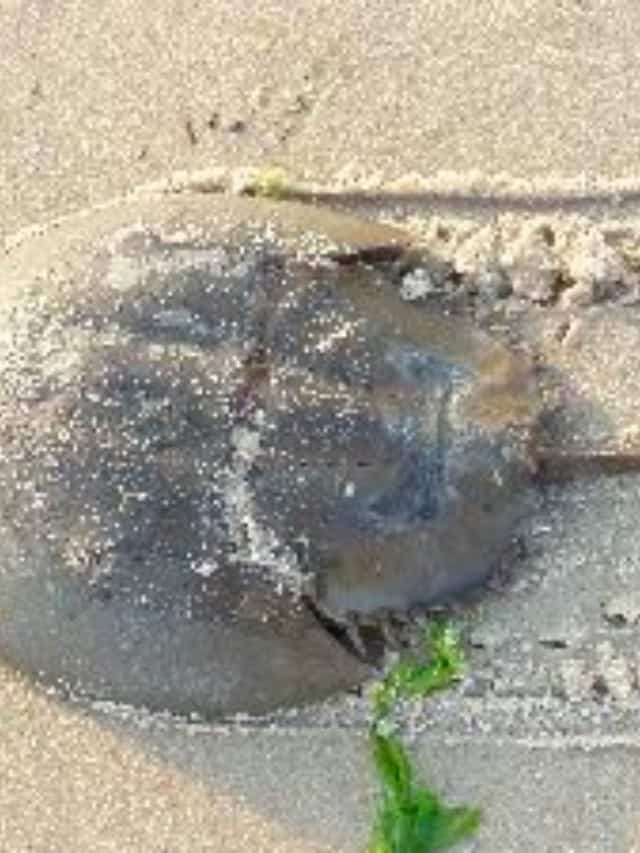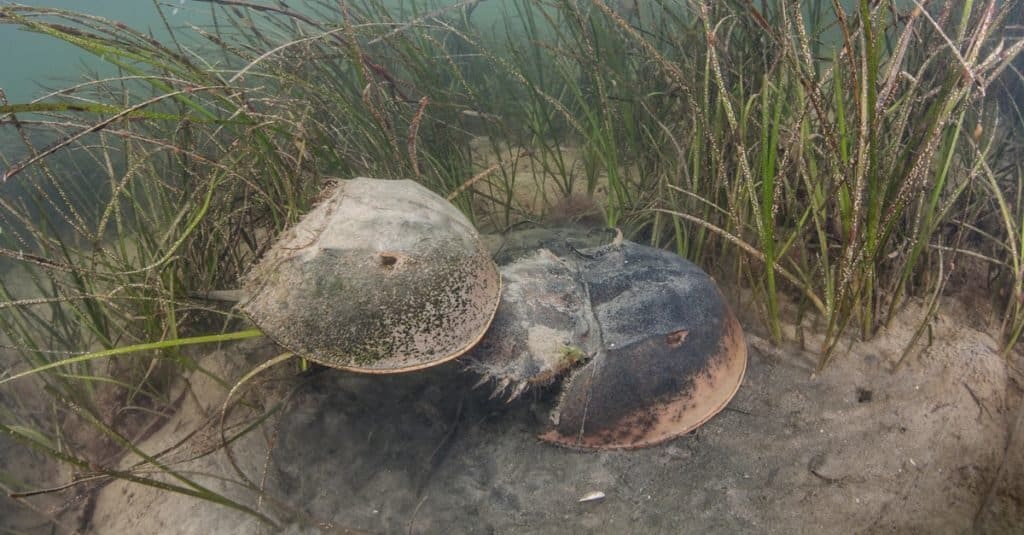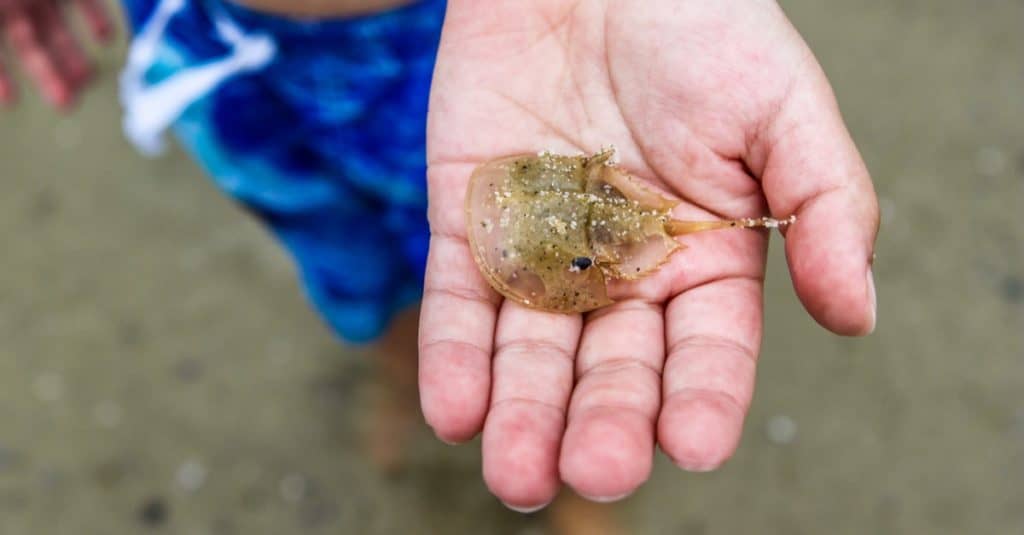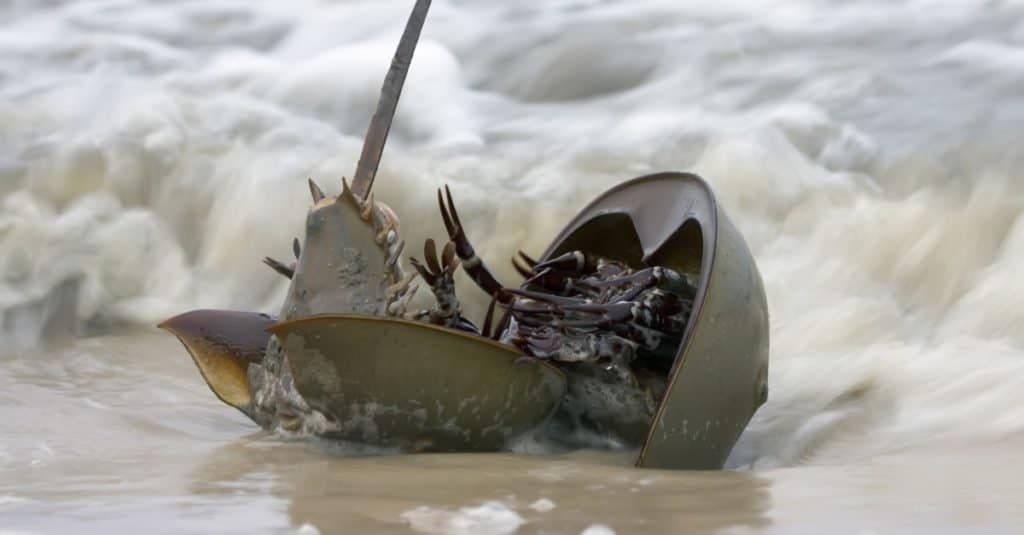The horseshoe crab is an arthropod in the family Limulidae. These living fossils have been around for millions of years, but few of the numerous species still roam the earth. There are four extant species; Carcinoscorpius rotundicauda, Limulus polyphemus, Tachypleus gigas, and Tachypleus tridentatus. Found in shallow coastal waters and brackish, intertidal zones, horseshoe crabs live throughout Southeast Asia, the Gulf of Mexico, and the Atlantic coast. Here are 10 incredible horseshoe crab facts that demonstrate what makes these ancient arthropods so amazing.
10. Horseshoe Crabs Are Remarkably Old

Horseshoe crabs are incredibly old.
©Shura007 / public domain – License
First up on our list of horseshoe facts is a fact that almost defies belief. Horseshoe crabs are one of the most ancient life forms on the planet. They are “living fossils” that roamed the earth in the time before the dinosaurs yet have managed to survive to the present day.
Scientists have discovered horseshoe crab fossils dating back to the Lower Ordovician period. The earliest horseshoe crabs evolved nearly 480 million years ago, although most of these species are now extinct. Of these, only four living species remain, all of which belong to the last extant horseshoe crab family, Limulidae. Modern horseshoe crabs look almost identical to their prehistoric ancestors, except that the abdominal segments in modern species are fused together rather than separate, as is the case with extinct species.
9. Horseshoe Crabs Aren’t Actually Crabs
Despite their name and appearance, horseshoe crabs aren’t crabs. In fact, they aren’t crustaceans at all and are actually arthropods in the subphylum Chelicerata. This means they are more closely related to sea spiders, scorpions, and other arachnids than to the crustaceans whose name they share.
The closest relative of the horseshoe crabs is likely the sea scorpion, a now extinct group of sea creatures that were among the largest arthropods ever to roam the earth. Still, other scientists claim that horseshoe crabs are more closely related to the now extinct Chasmataspidids, a clade of arthropods closely resembling both horseshoe crabs and sea scorpions.
8. Horseshoe Crabs Only Mate Under Specific Conditions

Breeding horseshoe crabs in captivity is difficult.
©Ethan Daniels/Shutterstock.com
Horseshoe crabs breed during spring and summer in colder climates and year-round in warmer regions. During the breeding season, they will travel to shallow waters along coastlines in order to breed. Delaware Bay is one of the most famous spots where horseshoe crabs congregate to breed. Every May, thousands of horseshoe crabs arrive to mate on the shores of the Bay, although the choice of spot still puzzles researchers.
To this day, scientists aren’t entirely sure what draws horseshoe crabs to specific locations. Some experts believe that horseshoe crabs will only mate in the presence of certain types of sand or mud. However, it’s not clear what draws horseshoe crabs to specific sites. Moreover, breeding horseshoe crabs in captivity is notoriously difficult, which only provides further proof that horseshoe crabs are very picky breeders.
7. Female Horseshoe Crabs Can Lay Thousands of Eggs
When mating, the smaller male crab will climb onto the female’s back using its small front claws. These claws leave marks on the female’s shell known as “mating scars” that accumulate over time. The female then lays her eggs in the sand, and the male comes by and fertilizes the eggs. Other males may also come by to fertilize some of the eggs, with varying degrees of success.
Horseshoe crabs are one of the most prolific breeders on the planet. A single female can lay up to 120,000 eggs at a time in several batches containing tens of thousands of eggs. It’s essential that horseshoe crabs lay so many eggs, as a large number are eaten by predators. The eggs that survive hatch after around two weeks.
6. Horseshoe Crabs Are Extremely Sensitive to Light

Horseshoe crabs are very sensitive to light.
©Fernando Losada Rodríguez, CC BY-SA 4.0, via Wikimedia Commons – License
Next up is one of the more eye-popping horseshoe crab facts. Horseshoe crabs have 10 eyes around their body. The eyes are positioned at different spots on the body. They include two compound lateral eyes, a pair of median eyes that detect both regular and ultraviolet light, a parietal eye, and two other basic lateral eyes on top. Altogether, these eyes help horseshoe crabs to navigate, look for food, and find other horseshoe crabs.
Despite having so many eyes, horseshoe crabs do not have great eyesight. As a result, they have the largest rods and cones in the eyes of any animal on earth. Additionally, they have extremely sensitive eyes, particularly during the day. In fact, they are nearly a million times more sensitive to light at night compared to the day.
5. Horseshoe Crabs Can Swim Upside-Down
Along with numerous eyes, horseshoe crabs also have several legs numbering 10 in total. Five of the pairs, or pedipalps, are used for locomotion. In the males, the pedipalps change over time and eventually become glove-shaped so as to help them better hold on to females during mating. Like other arthropods, the front two legs, or chelicerae, or smaller and are specially designed to help the crabs move food into the mouth.
Although they appear rather clumsy on land, horseshoe crabs can move rather freely in the water. They possess a flap-like structure next to the abdomen known as book gills that allow them to breathe underwater. However, these gills also provide another benefit: the ability to swim upside-down. These underwater acrobatics demonstrate that there’s more to horseshoe crabs than meets the eye.
4. Some People Consider Horseshoe Crabs a Delicacy

In places like Thailand, horseshoe crabs are considered delicacy.
©Kim Miller Media/Shutterstock.com
Horseshoe crabs have long been associated with the food trade. People often use them as bait for catching eels, whelk, or conch, although this practice has fallen into disfavor. Meanwhile, horseshoe crab eggs are frequently consumed in areas of Southeast Asia as well as China.
In Thailand and Malaysia, some horseshoe crabs are sought after by gourmands. Female T. gigas horseshoe crabs are considered by some to be a delicacy. As a result, the population of T. gigas in the region has plummeted in recent years as females have been plucked from the supply. This has led to an imbalance in the local ecosystem that will only exacerbate as long as the targeting selection of females for consumption continues.
3. Scientists Value Horseshoe Crabs For Their Blood
Next up is one of the weirder horseshoe crab facts. In addition to being popular food items, horseshoe crabs are also sought after for their blood. Their blood blue contains amebocytes, which are used to create Limulus amebocyte lysate, or LAL. This substance is used to test for bacteria and other uses in the pharmaceutical and medical industry.
To collect the blood needed for medical use, hundreds of thousands of horseshoe crabs are caught every year and bled. The crabs are then returned back to the wild. While the procedure is not designed to kill the crabs, anywhere from 3 to 30% of crabs die after being bled. The procedure has come under scrutiny in recent years. However, despite urges from activists to end the practice, events such as covid pandemic only served to heighten the demand for horseshoe crab blood.
2. Horseshoe Crabs Molt Until They Reach Maturity

Horseshoe crabs molt increasingly before maturity.
©Boris Z./Shutterstock.com
Like other arthropods, female horseshoe crabs are typically larger than males. On average, females measure around 20 or 30 percent larger than males. The largest females can measure around 31 inches long and weigh about 9 pounds.
During the first few years of life, horseshoe crabs grow through massive changes. Before they’re a year old, they molt nearly 6 times. With each molt, they measure around 33% larger. Once they reach around a year old, they molt less often and will continue to molt until they’re around 10 years old. By the time they reach maturity, most horseshoe crabs will have shed their exoskeleton around 16 times.
1. The IUCN Lists Horseshoe Crabs as Endangered
Unfortunately, our final entry on our list of horseshoe crab facts is one of the saddest. As previously mentioned, horseshoe crabs are frequently caught both for their food as well as their blood. While bleeding is meant to keep the crabs alive, many still die as a result of the procedure. Meanwhile, many more crabs are caught each year for food, while others are consumed by seabirds and other predators.
Due to overfishing and collection for the needs of scientific research, horseshoe crabs are on the decline. Their status is even more at risk due to development along coastlines where horseshoe crabs breed. Some native populations, such as those in Thailand, are facing extinction. Others have seen their population plummet by nearly 90% in the past few decades. As a result, the IUCN lists some species as Endangered and others as Vulnerable.
The photo featured at the top of this post is © tatui suwat/Shutterstock.com
Thank you for reading! Have some feedback for us? Contact the AZ Animals editorial team.






